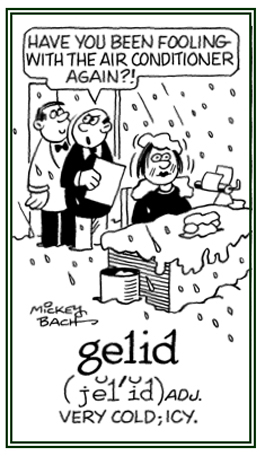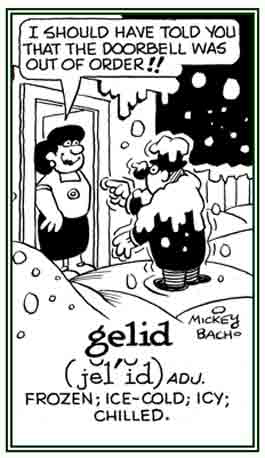gel-, gela-, gelati-, gelatino-, geli-, gelo-
Later it came to mean "to congeal"; having to do with "congealing" or with "gelatin, a protein derived from the partial hydrolysis of animal skin, connective tissue, and bone".
Don't confuse words from this Latin element with those from Greek gelo-, geloto-, meaning "laugh, laughing, laughter".
Referring to something that has the form of gelatin or formed like gelatin: Dr. Smith helped out operating and discovered a gelatiniform membrane which was attached to a nerve fibre.
gelatinize
(verb), gelatinizes; gelatinized; gelatinizing
To convert into a jelly-like mass: Susan stirred the mixture long enough to
gelatinize it so that the consistency was perfect before she put it into the fridge.
In her cookbook, Mrs. Black read that hot or boiling water would galatinize starch.
gelatinoid
(adjective), more gelatinoid, most gelatinoid
Pertaining to or resembling gelatin; jelly-like, gelatinous: Lucy used a gelatinoid substance with collagen, an ingredient in her cosmetics, to make her face look younger.
Dissolving or splitting up gelatin: In her class in biochemistry, Leah learned about gelatinolytic processes involving the enzymatic breaking up of gelatine.
gelatinosa
(s) (noun) (no pl)
A gray ggelatinous mass of gray matter that is found on the doors: John learned in medical school that the gelatinosa was a portion of the nervous system.
gelatinous
(adjective), more gelatinous, most gelatinous
Pertaining to or resembling gelatin; jellylike: A gelatinous substance varies with moisture conditions and is often a reference to a layer or part of a fungus.
gelatinousness
(s) (noun) (no pl)
The property of having a viscosity like jelly: The gelatinousness of the food Lynn had to have following her operation looked awful and was totally tasteless and bland.
gelation
(s) (noun), gelations
(pl)
Solidification by cold, freezing: Virginia's mother decided to make jello for desert, and put the liquid mixture into the fridge for
gelation
In other words, gelation is the process of something becoming solid by cooling; a cooling and solidifying.
gelato
(s) (noun), gelati
(pl)
An Italian ice cream made from milk, gelatin, sugar, and fruit: While on vacation in Venice, Max and Moritz loved eating
gelato on hot days.
Gelato is also a rich ice cream, made with eggs and usually containing a relatively low percentage of butterfat.
gelato-ology, gelatoology
(s) (noun); gelato-ologies; gelatoologies
(pl)
The scientific study of the art, taste, and texture of "gelato", and in this case, an Italian ice cream or "ice": Gelato-ology is an Italian ice cream with almost no air and thereby denser than other ice creams.
gelatose
(s) (noun), gelatoses
(pl)
An intermediate product in the hydrolysis of gelatin; glutose; or glutinose: Gelatose can be combined with glucose to mate lactose in breast milk.
gelatripsy
(s) (noun) (no pl)
The massaging away of indurated swellings:
Gelatripsy is a surgical method in which an abnormal enlargement of a body part is intentionally rubbing away.
Gelatripsy is not to be confused with "gelotripsy".
Botany, a plant that grows in geloid soils that have a crystalloid content of between 0.2 and 0.5 parts per thousand: Mr. Tree asked his students to find out which types of
gelicole species of vegetation thrive in gelisol, a kind of soil that is found in cold climates.
Geloid soil is characterized by low salt content, weak solutions, strong colloidal properties and a crystalloid content of less than 0.5 parts per thousand.
gelicolous
(adjective), more gelicolous, most gelicolous
A form of life that thrives in a gelisol: Two examples of gelicolous flowers are the Peony and the Coneflower (Echinacea purpurea).
1. Very cold; icy: Marilyn's
gelid feet are starting to warm up now because she is standing near the fireplace.
2. Freezing, frosty: This is the most
gelid day Jill and Jack have had so far this winter.
 © ALL rights are reserved.
© ALL rights are reserved.
 © ALL rights are reserved.
© ALL rights are reserved.
 © ALL rights are reserved.
© ALL rights are reserved.
Go to this Word A Day Revisited Index
for a list of additional Mickey Bach illustrations.
Cross references of word families that are related directly or indirectly to "winter, freezing, frost, and/or cold":
algid- (cold, chilly);
cheimo-, chimo- (winter, cold);
crymo-, krymo- (cold, chill, frost);
cryo-, kryo-; (cold, freezing);
hiber- (winter, wintry);
pago- (cold, freezing);
psychro- (cold);
rhigo- (cold, frost; shiver).





